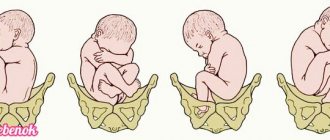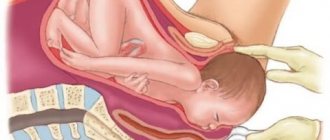Ideally, every pregnancy should end in childbirth. In life, everything is much more complicated: wanted pregnancies sometimes end in arbitrary termination, unwanted ones - in abortion; childbirth can be successful or complicated; babies are born healthy and sick...
Many families deliberately plan to have only one child, but, fortunately, there are those who are ready to give birth to several. Be that as it may, you need to prepare for childbirth both physically and psychologically, regardless of whether it is your first, second or tenth birth. With the first ones, everything is clear to everyone: preparation is definitely needed. Why prepare for the second and subsequent births? It turns out that multiparous women have as many questions about childbirth as primiparous women, or even a little more. Let's figure it all out.
At what stage does the second birth occur?
The opinion is firmly rooted in society that second and subsequent births occur earlier than the first. Naturally, such a scenario is quite likely (especially since the weight of the fetus is no longer held by the cervix as firmly as it was the first time), but it is not at all necessary! The number of pregnancies in the past or their absence does not have a significant effect on the gestation period of the baby.
Your second baby can be born when you are ready. But it is also possible that it will linger in the womb: there are many cases where the second birth took place after 40 weeks, and through stimulation. So don’t set yourself up to give birth at 37 weeks. However, as you know, this may well work: often childbirth occurs exactly at the time for which the mother has “programmed” herself: before her husband’s vacation, after the parents come to visit, on the father’s birthday, or on New Year’s Eve.
It is completely normal to give birth to your second child on time or within a few days of your expected due date. So a premature second birth is definitely a myth!
The connection between pain and fear
The biological purpose of pain is to protect. As a result, muscle activity and bodily tension increase, and the person is ready to confront the threat. Pain is closely related to the animal fear of damage, and damage is associated with pain. That is, fear warns us of danger, which the brain associates with pain and injury. Stress in this chain is a response that is accompanied by a surge of adrenaline and norepinephrine. The central nervous system activates impulses that warn of a threat, increase muscle tone and inhibit conditionally unnecessary body functions. Internal organs are not needed for concentrated tension and readiness for action.
All this means that wild pain during childbirth is a consequence of tension that prevents the uterus from contracting. Tension comes from fear. If you are afraid of giving birth, convinced that it will be terribly painful and dangerous, then wariness and anticipation of fear will inevitably cause tension and pain. Your ANS is sensitive to fear and can affect the nerves in the sacrolumbar spine and pelvic organs.
Pain depends on fear. It is the fear and expectation of painful sensations that leads to discoordination of labor, and here it no longer matters whether the pain is real or launched as a response to an imaginary threat.
The connection between pain and fear
How long does the second birth last?
Doctors say that the second birth is faster and easier. The birth of the first child takes on average 11-12 hours, the second - only 7-8. During the second birth, the time is reduced at all stages: during repeated births, the cervix is softer, more elastic, stretches more easily, which means it will open earlier, because during repeated births it both contracts and opens at the same time; the second stage - pushing - is much more energetic, since the body “remembers” the previous birth and easily enters the phase of expulsion of the fetus. A multiparous woman breathes and strains more competently, and can “push out” the baby in just a few minutes.
At the same time, doctors state: every birth is unique and individual, no matter what kind of birth it is. The mothers themselves agree with this opinion: many of them gave birth much longer the second time than the first. Therefore, each birth is treated with full responsibility, carefully prepared and, naturally, worried.
Psychological aspect of second birth
At first glance, there may not be any nuances here. The second pregnancy is conscious, which means the woman is psychologically ready for the upcoming birth. But it is not always the case. Even the second and subsequent pregnancies, like the first, can be planned or “accidental”. In both cases, the woman will again have to face the process of childbirth, which in any case is quite painful. Sometimes a woman is not ready to give birth to a second child precisely because of the fear of the birth itself. This usually happens if the first birth was quite difficult. But even those women who gave birth to their first baby easily and quickly are afraid of subsequent ones.
Statistics still claim that from a psychological point of view, a woman is more ready for the second birth, and during the process of childbirth she behaves confidently and calmly under any circumstances.
But how can you force yourself to overcome the fear of upcoming birth? First of all, you need to get all bad thoughts about previous births out of your head, erase them from your memory and not discuss the difficult births of your friends and acquaintances. It’s easy for a multiparous woman to switch, because she has so many worries with her first child. Indeed, you don’t need to be afraid of childbirth, but to prepare your first baby for the arrival of a brother or sister in the house. Well, then, you clearly realize that no one can give birth instead of you, and you probably remember how the first time you were prevented from breathing correctly and pushing was precisely ignorance: what will happen next? Now you are no longer a beginner, which means you will be more experienced in childbirth. Believe me, at the right moment you will easily figure out what and how.
The connection between pain and motherhood
The overwhelming number of expectant mothers are afraid not of labor itself, but of severe pain. Childbirth is seen as both a long-awaited meeting with the baby and a total threat associated with agony. Even promises of “painless”, “soft” childbirth seem to emphasize: normal labor is very painful. How then did our mothers and grandmothers give birth to children, and even more than once? And should there be pain of unnatural intensity during such a natural process?
The experience of fast and easy childbirth in Western countries is enormous. However, now we are seeing a radically different picture: girls tell each other that giving birth is terrible, and that if they had known about this, they would never have decided to conceive.
For the first time, the English obstetrician Grantley Dick-Read was puzzled by where painful sensations come from. He found out that the main cause of pain during childbirth is fear of it. A factor that increases pain is the inability to breathe deeply and the inability to relax the muscles in the process.
The connection between pain and motherhood
How is the second birth? Physiological aspect
Nothing new will happen here. Like the first, the second birth has three stages: dilation of the cervix (contractions), the period of expulsion of the fetus and the birth of the placenta:
- Contractions. After the first contraction, the body itself will remember how painful and painful it is. In this condition, a woman may require labor pain relief, but you will simply need to calm down and switch to properly experiencing contractions, thanks to which you will give birth to your baby. You’ll have to remember about comfortable positions; right now your husband can come in handy with an effective massage. During a contraction, you need to relax, taking deep breaths and exhalations.
- Attempts. Listen to the advice of obstetricians and gynecologists and trust them completely. In order for pushing to be as effective as possible, it is important to be able to hold your breath and properly release air through the tension of the abdominal muscles. Practice shows that during the second birth, most women push correctly and effectively, so be calm about yourself.
- Birth of the placenta. If during the first birth a woman felt discomfort during the birth of the placenta, then during the second birth no attention is usually paid to this procedure. All emotions are directed at the baby, who reflexively searches for the mother’s breast with his lips, and the mother herself, joyful and tired, is mentally preparing for the postpartum period, for returning home, where she can fully feel her true maternal happiness, being next to both children.
All this awaits you during the normal course of childbirth. However, unpredictable situations may arise for which it is not always possible to prepare in advance. In any case, you should calm down and rely on specialists. This is the only way you can help yourself and your baby.
There are also situations when the course of the second birth can be predicted based on the woman’s health status, the course of the previous birth and many other factors.
More on the topic
Contractions during the second birth
How are the second births different from the first?
When and what should you wear to the maternity hospital for the first and second births?
How to behave during labor and labor so that you can give birth easily?
How long does labor last for first-time mothers?
Mechanism of pain generation
To understand how pain occurs during childbirth, you need to understand the mechanism of pain itself. When we are in pain, the receptors of the organ that hurts are turned on - they have received the necessary signal.
The intestines and neighboring organs, especially the uterus, are not exposed to cold and warm temperatures, as they are securely covered by the abdominal wall. But they are equipped with pain receptors that respond to tissue stretching and tearing. The uterus, when compared with other organs, has a meager number of receptors. It does not respond to displacement and burns, but responds to tissue stretching and the threat of rupture with a pronounced pain impulse and shock. Receptors of the uterus and abdominal organs respond only to specific types of stimuli - tension with the threat of rupture and the rupture itself.
According to the law of physiology, any structure adapts to the function it performs. And the way the female reproductive organs are structured completely adapts to what they are actually needed for. Childbirth, one way or another, must be accompanied by stretching and tearing, which means the uterus is able to withstand it. And the woman too.
Mechanism of pain generation
Twice mom. What do you need to remember?
- Preparing for childbirth. A children's room, a dowry for the baby, things for the maternity hospital - all this should be ready long before the expected date of birth. By the way, before giving birth, check the list of necessary things for the maternity hospital. It is also important to choose a doctor and the maternity hospital itself, if there were problems with this the previous time. Consider also partner birth, especially if this is your first time giving birth yourself. Although it may be the other way around - the first birth took place with your husband, and the second time you want to refuse this option. In any case, it is better to resolve this issue in advance.
- When to go to the maternity hospital. During the first birth, it often happens that, having felt the first contraction, a woman runs to the maternity hospital, and she is sent back home. During the second birth, mommy is no longer in a hurry to go to the hospital, but she has to! Considering the above about the transience of repeated births, do not let it get to the point where you have to give birth on the way to the maternity hospital in the back seat of the car.
- Contractions. After the first contraction, the body itself will remember how painful and painful it is. In this condition, a woman may require labor pain relief, but you will simply need to calm down and switch to properly experiencing contractions, thanks to which you will give birth to your baby. You’ll have to remember about comfortable positions; right now your husband can come in handy with an effective massage. During a contraction, you need to relax, taking deep breaths and exhalations.
- Attempts. Listen to the advice of obstetricians and gynecologists and trust them completely. In order for pushing to be as effective as possible, it is important to be able to hold your breath and properly release air through the tension of the abdominal muscles. Practice shows that during the second birth, most women push correctly and effectively, so be calm about yourself.
- Birth of the placenta. If during the first birth a woman felt discomfort during the birth of the placenta, then during the second birth no attention is usually paid to this procedure. All emotions are directed at the baby, who reflexively searches for the mother’s breast with his lips, and the mother herself, joyful and tired, is mentally preparing for the postpartum period, for returning home, where she can fully feel her true maternal happiness, being next to both children.
All this awaits you during the normal course of childbirth. However, unpredictable situations may arise for which it is not always possible to prepare in advance. In any case, you should calm down and rely on specialists. This is the only way you can help yourself and your baby.
There are also situations when the course of the second birth can be predicted based on the woman’s health status, the course of the previous birth and many other factors.
- The interval between the first and second births. Childbirth is a great stress for every woman, after which the body needs adaptation and recovery. Previously, our grandmothers gave birth to children almost every year. Today, birth intervals have increased dramatically. For a complete recovery after the first natural birth, a woman will need about 2 years, experts say. After this time, you can plan for a second child. If more than 10 years pass between births, then there is a high probability of a complicated pregnancy and the birth itself. Although in practice this is not always the case. Women calmly give birth to a second baby both after one year and after a ten-year break.
- Age of a multiparous woman. Today, there are known cases of women giving birth at 45 for the first time without serious pathologies. Therefore, the question about the age of the expectant mother should not be raised. However, doctors still strongly recommend that all planned children be born between the ages of 20 and 35 - this is the most favorable period for childbearing without any complications. With age, a woman “acquires” many diseases, so the course of pregnancy and childbirth can be unfavorable.
- Health status. For a good outcome during the second birth, naturally, the woman must be absolutely healthy. In the presence of chronic diseases (diabetes mellitus, heart disease, bronchial asthma, etc.), repeated births can occur with complications. To make this process as safe as possible, you need to prepare in advance for pregnancy and childbirth, be under the strict supervision of doctors and follow all their instructions. Complications during the second birth can also arise if the woman previously had abortions or had spontaneous miscarriages. Inflammatory diseases of the female genital organs before the second pregnancy will also not have the best effect on childbirth.
- C-section. There is an opinion that if the first birth took place through surgery, then the second child will not be able to be born naturally. However, it all depends on the reasons why the woman had a caesarean section for the first time. Anatomically narrow pelvis, severe chronic diseases of the mother, severe myopia, etc. – these are the indications for which natural delivery is unacceptable. If for the first time a woman was “caesareaned” because of a large fetus or breech presentation, and now these indicators are normal (the baby is head down and has an average weight), then the doctor may allow the woman to give birth on her own. But it also happens differently: the first birth was natural, but the second may have a number of indications for cesarean section (serious ruptures of the cervix during previous births, suppuration of the sutures, changes in the structure of the birth canal, etc.).
Postpartum complications, compared to the first birth, can also be unpredictable and expected.
- Breaks. A normal second birth can be hampered by scars at the site of perineal ruptures during the first birth if they have not had time to heal. At the same time, the likelihood of repeated ruptures increases, because the tissue that makes up these scars becomes inelastic and, during repeated births, tears along the old seam or in new places. If the previous birth did not leave any scars, then the second one most likely will not. After all, after the first birth, the muscles of the perineum become more elastic.
- Postpartum bleeding. The risk of this condition increases with repeated births. It happens that the uterus does not contract, and postpartum discharge is retained in its cavity. Bleeding is also caused by scars on the uterus, previous infectious diseases, etc. However, postpartum hemorrhage can be prevented long before birth. To do this, you need to train the muscles of the uterus using special exercises.
In the midst of the process
So, the dilation of the uterus was good, and the contractions became so unbearable that at those moments I did not want this all to happen to me. After all, this was the first time I experienced such sensations. I wanted to come home to my favorite TV shows and books. But I understood that this was an irreversible process, and that here and now I had to give birth to my son.
I remember how I really wanted to walk, and the nurse allowed me. I barely scraped myself off the bed and walked around the room a little until the next contraction overtook me. The pain was so severe that my brain shut down and I completely forgot everything I had learned. I started doing everything wrong and wasn’t helping myself or my child at all.
You're probably wondering what this pain feels like? I will try to describe it as colorfully as possible. It's like experiencing the pain of menstruation, only multiplied by 10, and the whole body feels like it's undergoing some kind of torture. I remember how absolutely all the muscles were tense. Even standing with my elbows on the bed, I felt like they were about to burst, especially on my legs. I’m generally silent about the tailbone; it seemed like he wanted to go out with the child. Then it seemed to me that even my hair hurt.
The midwife was able to bring me to my senses, reminding me that I needed to calm down and start breathing correctly. Then I tried to get into a half-squat position and push, but it didn’t suit me very well. It was hard for me to stand like that, so there was no effect. Then I tried to lean my hands on the bed and push in this position, but it didn’t help me either.
Eventually they laid me on the bed and raised the rails so I could hold on to them. And lo and behold, it was this pose that became the most effective for me. But the incessant pain again blocked my brain, and I simply did not hear either the midwife or the doctor who delivered the child. They told me one thing, but I did something completely different.
In this unbearably long agony, I even begged for a caesarean section, but again the midwife brought me to my senses and said in a calm, monotonous voice: “No, Ksyusha, the only way, through this exit.” And I became so angry with her, with myself and with everyone that I pulled myself together and began to listen to what they were telling me.
I managed to adjust my breathing correctly. As I inhaled, I gained strength, and as I exhaled, I pushed the baby out. My doctor's encouraging words helped me reach my goal. And finally, after 10 hours of torment, a miracle happened! They put my little son on my chest, and I heard him meow. He actually meowed and didn’t cry, apparently he was also very tired then.
In that unforgettable moment, I felt true love and realized that the long hours of hellish torment were truly worth it. But it didn’t end there; we still had to try to degenerate the placenta. Then I didn’t care anymore, and the pain wasn’t felt as much anymore, so it went away very easily.
This is the story of my first, and so far only, birth, with a happy ending.
Features of preparation for the second birth
Train your pelvic floor muscles. Special exercises will help restore muscle tone immediately after the first birth, while the second birth will be much easier and faster.
Even before your second pregnancy, undergo a series of examinations and, if necessary, receive treatment.
If the first birth was premature, then there is a high probability of such an outcome the second time. To avoid this, avoid any physical activity, especially in the last trimester of pregnancy. It is also recommended in recent months to abstain from sexual relations that cause active contraction of the uterus.
Well, the most important factor for a successful birth is the positive attitude of the pregnant woman. Becoming a mother twice is a great happiness! (Verified by the author!)
Good luck with your second birth! Believe in your strength!
Especially for beremennost.net - Tanya Kivezhdiy









